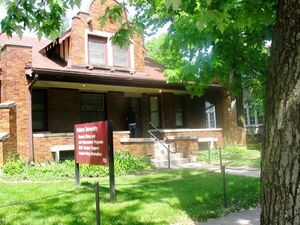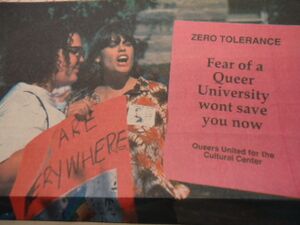Difference between revisions of "Establishing the GLBT Student Support Services Center"
m (Protected "Establishing the GLBT Student Support Services Center" [edit=sysop:move=sysop]) |
|||
| (11 intermediate revisions by one other user not shown) | |||
| Line 1: | Line 1: | ||
| − | The Gay, Lesbian, and Bisexual Student Support Services Center at Indiana University was first established in November of 1994, after many years of [[Image:Glbtoffice. | + | The Gay, Lesbian, and Bisexual Student Support Services Center at Indiana University was first established in November of 1994, after many years of [[Image:Glbtoffice.jpg|thumb|left|The GLBTSSSC's website can be found [http://www.indiana.edu/~glbt/ here].]]planning and work by several queer IU staff members. Today, the GBLT Center (as it is usually referred to by students; "Transgender" was added to the name in 1998) provides a gathering space for queer and queer-friendly groups, a campus hub for queer activism, and a library with resources on many issues of importance to queer people and allies. |
==Early History and Controversy== | ==Early History and Controversy== | ||
| Line 13: | Line 13: | ||
==Post-Foundation History== | ==Post-Foundation History== | ||
| − | The GLBT Center, which now occupies an entire house on 7th street, next to the La Casa (the IU Latino Cultural Center) and Student Legal Services, started as a much smaller operation. Since its inception, the Center has gained a library, in addition to interns in Social Work and Counseling positions. Accordingly, the Center offers counseling services to students and community members, especially for those dealing with issues related to being queer. | + | The GLBT Center, which now occupies an entire house on 7th street, next to the La Casa (the IU Latino Cultural Center) and Student Legal Services, started as a much smaller operation. Since its inception, the Center has gained a library, in addition to interns in Social Work and Counseling positions. Accordingly, the Center offers counseling services to students and community members, especially for those dealing with issues related to being queer. The GLBT Center also has a volunteer staff and a volunteer coordinator who aid in the day-to-day work of running the office, as well as offer help to other groups organizing events like Transgender Day of Remembrance or National Coming Out Day. |
===GLBT Alumni Association=== | ===GLBT Alumni Association=== | ||
| − | In 1996, Jeff Kinney received a grant from the IU Student Association to work with the GLB Center on a project of his choosing. After discussions with office employee Doug Bauder, Kinney decided to form a GLBT alumni group. In 1997, Kinney, Bauder, and IU alumna Cindy Stone presented the proposal to the IU Alumni Association and, by vote, received official recognition as an IUAA affiliate. Today the Alumni Association provides significant funding for the GLBT Center and the programs and events it hosts. | + | In 1996, Jeff Kinney received a grant from the IU Student Association to work with the GLB Center on a project of his choosing. After discussions with office employee Doug Bauder, Kinney decided to form a GLBT alumni group. In 1997, Kinney, Bauder, and IU alumna Cindy Stone presented the proposal to the IU Alumni Association and, by vote, received official recognition as an IUAA affiliate. Today the Alumni Association provides significant funding for the GLBT Center and the programs and events it hosts. The IU GLBTAA has over 1,000 members and maintains a website [http://alumni.indiana.edu/glbtaa/ here]. |
| + | |||
Sources | Sources | ||
| + | |||
Bajko, Matthew. “Conservatives oppose GLB center using University funds.” April 29, 1994, Indiana Daily Student. | Bajko, Matthew. “Conservatives oppose GLB center using University funds.” April 29, 1994, Indiana Daily Student. | ||
| Line 35: | Line 37: | ||
Welsh-Higgins, Andrew. “Students protest IU funding switch.” Oct. 18. 1994, The Herald Times. | Welsh-Higgins, Andrew. “Students protest IU funding switch.” Oct. 18. 1994, The Herald Times. | ||
| − | Wimmer, Amy. “Legislator stays firm in opposing GLB.” Oct. 7, 1994, Indiana Daily Student. <comments /> | + | Wimmer, Amy. “Legislator stays firm in opposing GLB.” Oct. 7, 1994, Indiana Daily Student. |
| + | |||
| + | |||
| + | |||
| + | <div style="text-align: center;"> | ||
| + | '''Navigation''' | [[The Midwest's "Queer Mecca": 40 Years of GLBTQ History in Bloomington, Indiana (1969-2009) | '''Home''']] | [[BEFORE STONEWALL: WHAT MADE BLOOMINGTON A GAY OASIS? | '''Before Stonewall''']] | [[FROM STONEWALL TO THE AIDS EPIDEMIC: 1969-1981 | '''Stonewall to AIDS: the 70s''']] | | ||
| + | |||
| + | [[AIDS, ACTIVISM, AND COMMUNITY VISIBILITY: 1981-1991 | '''AIDS and Community Life: the 80s''']] | [[QUEER BLOOMINGTON: 1992-2001 | '''The Queer Decade: the 90s''']] | [[QUEER HERE AND NOW: CONTINUITY AND CHANGE IN THE 21st CENTURY | '''Queer Here and Now: 2001-Present''']] | ||
| + | |||
| + | </div> | ||
| + | |||
| + | [[Category:Stryker]][[Category:Gay]][[Category:Lesbian]][[Category:Bisexual]][[Category:Transgender]][[Category:Indiana University]] <comments /> | ||
Latest revision as of 10:31, 1 May 2010
The Gay, Lesbian, and Bisexual Student Support Services Center at Indiana University was first established in November of 1994, after many years of

planning and work by several queer IU staff members. Today, the GBLT Center (as it is usually referred to by students; "Transgender" was added to the name in 1998) provides a gathering space for queer and queer-friendly groups, a campus hub for queer activism, and a library with resources on many issues of importance to queer people and allies.
Early History and Controversy
In addition to IU staff members and students, the IU administration was also instrumental in formulating early plans for the Center. In particular,then-chancellor Kenneth Gros Louis, IU President Myles Brand, and Dean of Students Dick McKaig all acted to ensure the establishment of the center.
Funding Controversy
Several state legislators strongly opposed to the creation of the GLBT Center attempted to block its formation on several grounds. In particular, Woody Burton, representative for most of nearby Johnson County in the Indiana House, objected on the basis that homosexuals did not constitute a legitimate minority and that thus University funding for the office was inappropriate. To enforce this view, he and other like-minded senators threatened a $500,000 cut to IU's operating budget if University money was used to pay for the Center's establishment.
Myles Brand, in a decision that proved unpopular with both those objecting to the Center and supporting it, opted to use private funding to support the GLB Center. This prompted protests from queer groups, including a Bloomington Lesbian Avengers chapter and the campus group Queers United for Equal Social Treatment, or QUEST, who viewed the decision as
giving in to conservative political and financial pressures. However, this solution has proven effective, and even today most of the Center's funding comes from the IU Foundation and the IU GLBT Alumni Association.
Post-Foundation History
The GLBT Center, which now occupies an entire house on 7th street, next to the La Casa (the IU Latino Cultural Center) and Student Legal Services, started as a much smaller operation. Since its inception, the Center has gained a library, in addition to interns in Social Work and Counseling positions. Accordingly, the Center offers counseling services to students and community members, especially for those dealing with issues related to being queer. The GLBT Center also has a volunteer staff and a volunteer coordinator who aid in the day-to-day work of running the office, as well as offer help to other groups organizing events like Transgender Day of Remembrance or National Coming Out Day.
GLBT Alumni Association
In 1996, Jeff Kinney received a grant from the IU Student Association to work with the GLB Center on a project of his choosing. After discussions with office employee Doug Bauder, Kinney decided to form a GLBT alumni group. In 1997, Kinney, Bauder, and IU alumna Cindy Stone presented the proposal to the IU Alumni Association and, by vote, received official recognition as an IUAA affiliate. Today the Alumni Association provides significant funding for the GLBT Center and the programs and events it hosts. The IU GLBTAA has over 1,000 members and maintains a website here.
Sources
Bajko, Matthew. “Conservatives oppose GLB center using University funds.” April 29, 1994, Indiana Daily Student.
Bauder, Doug. Interview by Katherine J. Roberson. 17 Nov 2008.
Goldman, Alyssa. “A story never told.” Oct. 11, 2009, Indiana Daily Student, p.1. http://www.idsnews.com/news/story.aspx?id=70556&search=myles brand§ion=search (accessed December 3, 2009).
Marijke Rowland. “Zero Tolerance plans to question Brand during his address tonight.” Oct. 19, 1994, Indiana Daily Student.
Pearlman, Russel. “Brand defends GLB office decision.” Oct. 20, 1994, Indiana Daily Student.
Thomas, Wendy. “Gay-support office approved for IU Bloomington Campus”. The Indianapolis Star, June 4, 1994.
Welsh-Higgins, Andrew. “Students protest IU funding switch.” Oct. 18. 1994, The Herald Times.
Wimmer, Amy. “Legislator stays firm in opposing GLB.” Oct. 7, 1994, Indiana Daily Student.
Navigation | Home | Before Stonewall | Stonewall to AIDS: the 70s |
AIDS and Community Life: the 80s | The Queer Decade: the 90s | Queer Here and Now: 2001-Present
<comments />
